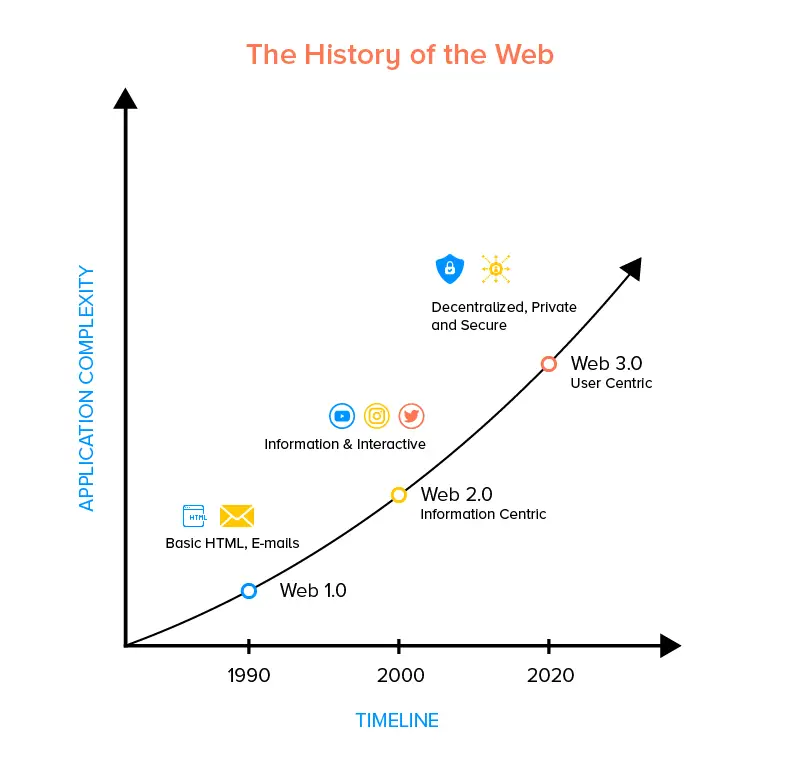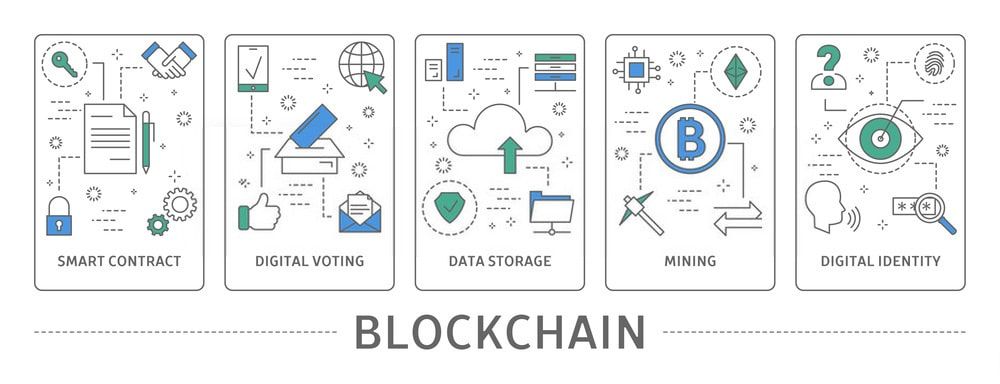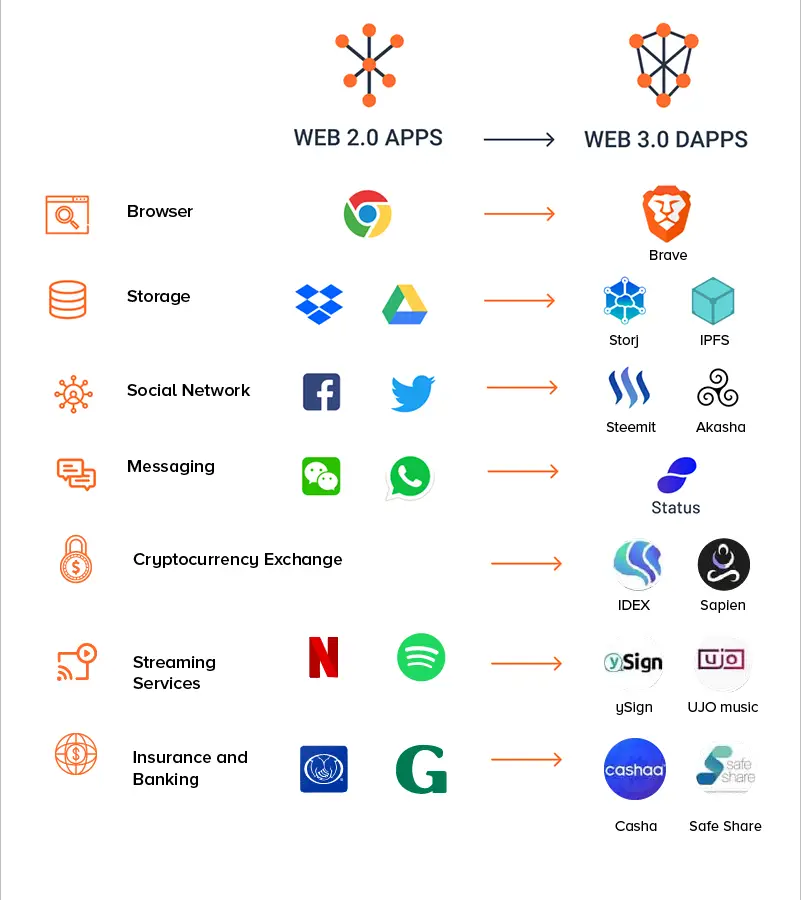The New Era of the Internet: Web 3.0.
The evolution of the Internet as technology advances is unavoidable.
Over the years, we have witnessed the evolution from a relatively static and non-interactive network to an Internet that surprises us more each day.
The terms web 1.0. 2.0. or 3.0 are nothing but words that reflect the evolution of the Internet and how it changed the way we use the world wide web.
The Journey to Web 3.0

What is Web 1.0
The primitive web of the 20th century was characterized mainly by being unidirectional and based on static content. Web 1.0 had an informative nature.
Documents and cultural information began to be posted on the Internet.
Gradually, companies began to take part, and the first company websites appeared. But their designs were poor (there were no tools, technology, or connection enough to make it better).
In the beginning, Internet users had only one role: to consume the information hosted on computer servers.
Navigation was purely textual, and queries were very limited.
When the web programming language HTML (HyperText Markup Language) appeared, the organization of the elements displayed on the screen became more attractive.
However, interactions were still very restricted because all the users could do was read the information. He wasn't allowed to comment on it, for instance.
What is Web 2.0
The main characteristic is that users are no longer passive but active.
Supported by evolved internet connections (ADSL was already available) and better tools for web development as well as better servers, web 2.0, also known as "the social network," filled the Internet with blogs, wikis, forums, and finally, social networks.
Its objective is to share knowledge.
It is known as the collaborative web, the main feature that attracted thousands of users. Compared to web 1.0, Internet users can also generate information and publish it on websites, in user forums, blogs, social networks, and wikis.
What is Web 3.0
Web 3.0, also known as the semantic web, is presented as an intelligent web and mainly takes advantage of the cloud to provide services to users and eliminate their need for complex operating systems and large hard drives to store their information.
Web pages can be related in a semantic way, using metadata that adds value to the information and improves the search and the possibility of finding information on the web.
In Web 2.0, installing applications to use certain services was necessary. Before then, it was also required to install programs to communicate, such as the old Messenger.
It was not enough to simply have an Internet connection, a browser, and access a particular service.
However, this changed with the semantic web. We can now simply use the browser to access the same services.
This makes it much easier for users, especially when we use multiple services daily and don't want to install so many applications.
But there's a lot more to it.

Web 3.0 and Blockchain
Today's Internet is far from its original intention of being an open space, but Web 3.0 promises a future of an open, transparent, and creator-friendly Internet.
You've certainly heard of cryptocurrencies, but their widespread adoption remains difficult, and traditional technology gatekeepers maintain their grip on the digital economy.
Those who build the decentralized Internet—the semantic web—need to do a better job at loosening that grip.
The stakes are increasingly evident as we see how the structural inequalities of Web 2.0 affect us all.
A centralized internet means that there is always someone behind each and every movement, controlling everything.
To illustrate this, let's think about traditional banks.
You decide you want to make an online purchase. You pay using your credit card, and your balance may be held for a period of time, right?
This is because the bank has to confirm that the money used is valid, not duplicated, or counterfeit.
Furthermore, the banks need to make sure that the other party receives the money, fulfils their services, and is not committing fraud of any kind.
As you can see, it requires a lot of time and effort.
This is where Blockchain comes in, a decentralized network that allows all users in the chain to access the information - not just the bank.
Let's take it one step at a time.
What is Blockchain?

Blockchain is a distributed, unchangeable ledger that makes recording transactions and managing assets in a corporate network much easier.
A tangible asset (a house, a car, cash, or land) can be intangible (intellectual property, patents, copyrights, and trademarks).
On a blockchain network, virtually anything of value may be recorded and sold, lowering risk and costs for all parties involved.
A blockchain essentially cuts out the intermediaries, decentralizing all management.
The control of the process belongs to the users, not to the banks — we are still talking about money, but the example is applicable to every transaction.
It is the users who become part of a huge bank with thousands, millions of nodes, each of which becomes a participant and manager of the bank's account books.
How Does Blockchain Work?
A transaction is recorded as a "block" of data as it occurs. These transactions depict the movement of a tangible (a product) or intangible (a service) asset (intellectual).
Each block is linked to the previous one and the one after it. As an object transfers from one location to another or changes ownership, these blocks form a data chain.
The blocks are securely connected to prevent tampering or insertion between two existing blocks, and they certify both the exact time and sequence of transactions.
Why Are Risks And Costs Reduced?
Because everyone can access that ledger, you start to get the point, don't you? In traditional financial institutions, only the banks are able to access the record of transactions and assets.
But with Blockchain, any user (node) on the chain can access it — and verify it.
Speaking about verifications, users work with their computing power to verify transactions.
The more powerful the computers are, the faster they can work. Nothing that goes into the Blockchain is fake. It is a decentralized system governed by users—an open-source. Everything is out in the open for everyone to see.
Benefits Of Using Blockchain
Increased Security
All network members must reach a consensus on the accuracy of the data, and validated transactions are unalterable as they are permanently recorded.
No one can delete a transaction—no more fraud.
Businesses Operate On Information
Blockchain provides completely transparent, immediate, and shared data stored in an unalterable distributed ledger.
A blockchain network will track orders, payments, accounts, production details, and much more.
Since users share a single authoritative source of information, you can see every minor detail of the transaction, allowing you to build greater trust and efficiency, as well as gain more opportunities.
Distributed Ledger Technology
The distributed ledger and its immutable record of transactions are accessible to all network participants.
Transactions are only recorded once with this shared ledger, eliminating the duplication of effort that is common in traditional corporate networks.
Unalterable Records
No participant is able to change or falsify a transaction once it is recorded in the ledger.
What About Privacy?
If I want to withdraw crypto from my account to hand it over to you, I have to notify the entire Blockchain.
But there is a peculiarity. Nobody knows who I am or who you are.
The information they can access is from my digital wallet (equivalent to a bank account) from which I want to transfer money to you. Users know what our digital wallets are and what money we are going to transfer, but our identity remains anonymous.
The Blockchain, while protecting the privacy of its users, does allow the traceability of these transactions to be controlled.
Web 3.0 Key Features
Intelligence
Web 3.0 aims to create a method for classifying pages with a tagging system that not only allows search engines to find information but also to understand it.
The user will be able to go to the Web to ask questions in their mother tongue without the need for keywords on a given subject.
The Web will learn from the search results for future searches.
Sociability
Social communities grow more complex. Social networks and how they connect their members expand. Thus, having multiple identities in the virtual world becomes normal.
Speed
The main telecommunications operators have begun to provide fibre optics to users with bandwidths of up to 3Mbps of ADSL that will increase to speeds ranging from 30Mbps to 1000 Mbps.
Open-source
Free software, standards, and Creative Commons licenses have become the norm on the Internet. Information is distributed freely across the web, preventing a single owner from monopolizing it.
The use of information becomes more democratic.
Ubiquity
Small screens grow in size and resolution, allowing better visualization of web content. The generation of wireless and telephony networks is multiplied, expanding the network coverage.
Ease of Use
Internet users who visit a website spend time getting familiar with it.
Web 3.0 seeks a more homogeneous Web, easier to recognize. It also aims to create spaces that the user can configure to their liking.
Three-dimensionality
Three-dimensional spaces, in the form of virtual worlds or games, will gradually become more common.
There will be new devices for navigating the spatial web, alternatives to the typical keyboard and mouse.
Web 3.0 Examples And Uses

Siri is probably the most used Web 3.0 application we are all familiar with.
Voice recognition software-based applications like Siri are becoming the future.
Voice recognition software is, in fact, quickly becoming a major element of Web 3.0. Siri is an excellent illustration of where Web 3.0 is leading computer users, with devices that can communicate with each other and deliver better search results.
Instead of the frustrating "I don't know" Siri and other personal assistants will gradually be able to provide more conclusive solutions and ideas.
Here are some examples of decentralized apps or dapps
Regarding social networks or social media, we can find:
Diaspora: The Diaspora platform doesn't only use blockchain, but also advanced technology such as artificial intelligence(AI) to create a hybrid of social networks and media.
It spreads useful information to readers according to their preferences, all with the help of AI algorithms. Thus, users get the high-quality content they seek.
Sapien: Sapien is one of the most unique examples of Web 3.0. It is a democratized social news platform that leverages the Ethereum blockchain and is highly customizable too.
It is an excellent alternative to big tech companies such as Google or Facebook regarding social news.
Regarding messaging services:
e-Chat: e-Chat is a decentralized blockchain Web 3.0 application that offers secure messaging. It is also one of the fastest-growing social networks.
Users get real freedom whereby they can also send cryptocurrencies.
Regarding decentralized web storage:
Storj: Storj is one of the leading decentralized storage solutions, as well as one of the oldest. With Storj, anyone can store data.
It is also open-source and easy to use. Anyone can start using it with just one click. The payment is built around the users; they pay according to their usage.
How To Be a Web 3.0 Creator?
Contrary to Web 2.0, the Internet is no longer just about consuming, but now we have the opportunity to create, interact, own our information, control our data and also be part of a fair distribution of wealth according to our contribution in each project.
For instance, if we verify data in the Bitcoin Blockchain, we will receive bitcoin tokens - which are valuable and can be transformed into "real" money.
Blockchain developers are also very limited in the market and the demand for them is high which makes them quite expensive to hire.
But that's not the only way to make a profit off Web 3.0.
Have You Ever Heard About NFTs?
NFTs (Non-Fungible Tokens) are the digital version of tangible or intangible products, such as stamps or art, to which users confer value.
These assets slowly gain importance with this new culture of smart contracts and cryptocurrencies; Yuval Noah Harari discussed this idea in his bestseller 'Sapiens: from animals to gods.'
He pointed out that the value of gold and silver was nothing but "purely cultural." We assign value to gold because the vast majority of the world population does as well.
Something similar happens with NFTs. We place value on them because others place value on them.
Some NFTs have been sold for millions of dollars, even though it is
a purely digital object like a work of art.
Remember what happened with the fever of Cryptokitties? How on Earth did an avatar of a cat fetch $115,000? or EVERYDAYS: THE FIRST 5000 DAYS that went for $69,346,250?
Enough people believed they cost that much.
Contrary to what happens with cryptocurrencies, you cannot exchange NFTs.
Each one of them is unique.
The Metaverse

The concept of metaverse describes a digital life parallel to real life. It is basically an idyllic virtual world where you can shop: socialize, work and play.
In this three-dimensional world, digital pursuits will certainly play an important role. Art, for example. The metaverse may become an opportunity for many creators.
Of course, all of this is very new.
We adapted to the Internet, social networks, and smartphones in a very short time. The metaverse may gradually gain its space.
The pioneers of this new world will be the first to benefit. That is why we must get in early. In the world of cryptos, the lament for being late is common. Why didn't we buy it in 2013? Why didn't we buy early?
Actually, it's not a matter of luck. It's a matter of vision. That means we need to be vigilant so that we don't miss the opportunities that come our way. It's as simple as that.
Is It Really The Future?
For the more sceptical and outdated-which is only natural- it may be hard to believe in the potential of something so apparently volatile and intangible.
But the reality is that blockchain technology is here to stay. The technology has had a huge impact on the economic side through new opportunities for companies that implemented e-commerce, allowing them to improve, amplify and facilitate their processes.
It has also had a significant impact on the world's finances at a macro level.
Let's think about some of the problems of today's world: The misuse of user data and the right to privacy or the loss of jobs replaced by Al-driven machines.
Blockchain is positioned as a new operating platform that helps businesses and the 21st-century economy to face these challenges.
According to Don Tapscott, executive director of the Blockchain Research Institute.
As Tapscott stated, we will be able to move from the Internet of information to the Internet of value. This means that each user will be able to assume and be responsible for their digital identity.
In other words, we will be the sole owners of our data and privacy in processes such as the purchases we make online, and the places we visit, among many other activities.
Blockchain represents one of the main tools to design the future of our economy.
Subscribe to our email newsletter and unlock access to members-only content and exclusive updates.

Comments